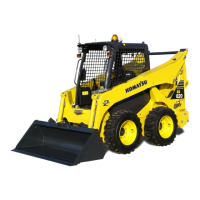
Do you have a question about the Komatsu SK820-5 turbo and is the answer not in the manual?
| Brand | Komatsu |
|---|---|
| Model | SK820-5 turbo |
| Category | Front End Loaders |
| Language | English |
Defines DANGER, WARNING, CAUTION signal words for hazard levels.
Defines IMPORTANT and NOTE signal words for precautions and useful info.
Specifies the intended uses for Komatsu machines.
Lists forbidden uses of the machine and related cautions.
Lists key features and characteristics of the machine.
Outlines the running-in procedure for new machines.
Explains where to find serial number and identification plate.
Locates engine, travel reduction gear, cab, and excavator serial numbers.
Provides fields to record serial numbers and dealer info.
Explains how to maintain and locate safety plates on the machine.
Explains meanings of warning and danger pictograms.
Details noise plates and operator vibration exposure.
Outlines safety rules, PPE, and clothing advice.
Importance of safety devices, guards, and warns against modifications.
Instructions for safely leaving seat and mounting/dismounting machine.
Precautions to prevent fires and avoid burns from hot components.
Safety for asbestos, work equipment, fire extinguishers, and first aid kit.
Advises on cab damage and using authorized optional equipment.
Safety for work area, fire prevention, and operator cab.
Ventilation, lights, and wiper checks before starting.
Procedures for starting engine and rules for road travel.
Checks before reverse travel and general machine moving.
Precautions for working on slopes and preventing electrocution.
Visibility, working on snow/ice, loose ground, and parking procedures.
Procedures and safety for loading/unloading and route planning.
Safety measures for battery work and booster starting.
Procedures for warning plates and tool usage/storage.
Rules for personnel, equipment handling, and working under the machine.
Importance of cleanliness and engine use rules during maintenance.
Critical parts for safety and stopping engine before maintenance.
Safety for refueling, coolant, lamps, battery, alternator, starter.
Safety for hoses, high-pressure systems, and high temp/pressure maintenance.
Safety for fan belt, waste disposal, and tyre inflation.
Specific safety for HEES oil usage.
Details the loader arm safety lock mechanism and operation.
Safety lock procedures for excavators/cutters during road travel.
Labeled diagrams of machine's front, rear, and interior views.
Explains dashboard instruments and warning lights.
Identifies switches, buttons, and electrical accessories.
Identifies main control levers and pedals.
Operation of safety bars and left joystick controls (ISO pattern).
Right servo lever, optional pattern controls, and accelerators.
Instructions for parking brake and equipment locking lever.
Operation of hydraulic systems and speed controls.
Operation of machine controls using hand & foot system.
Lists fuses for machine functions and their circuits.
Details the main fuse and identifies relay locations and types.
Instructions for opening engine hood and rear panel.
Information on cab structure and how to raise it.
Explains adjustment options for standard and cushioned seats.
Importance of safety belt and emergency exit procedure.
Location of documentation case, fire extinguisher, and first aid kit.
Essential visual, daily, and operational checks before starting.
Procedure for starting the engine in various conditions.
Steps for warming up engine and hydraulic oil.
How to move the machine using ISO pattern controls.
Explains steering and direction changes in ISO pattern.
How to move the machine using optional pattern controls.
How to change direction using joysticks in optional pattern.
Precautions for operating the machine on slopes.
Specifies the maximum safe immersion depth for the machine.
Step-by-step instructions for parking on level ground.
Procedures for safely parking the machine on slopes.
Procedures and safety for loading/unloading and route planning.
Recommendations for fuel, lubricants, and coolant in cold weather.
Battery and general cold weather operational precautions.
End-of-work precautions for cold weather.
Procedure for lowering equipment during failure.
Organizing work area and loading material on slopes/surfaces.
Correct and incorrect digging techniques.
Steps to change bucket using standard and optional rapid couplings.
Checking and adjusting the position of locking pins.
Precautions before, during, and after long-term storage.
Guidance on removing stuck machine and fuel depletion.
Battery depletion troubleshooting and booster starting.
Troubleshooting for electrical, hydraulic, engine, and transmission problems.
Notes on engine, hydraulic, electrical, and lubrication maintenance.
Lists parts that require periodic replacement.
Lists approved HEES biodegradable lubricants.
Tables for standard and specific driving torques for fasteners.
Diagram showing lubrication points and intervals.
Lists critical safety parts for fuel, hydraulic, and operator safety.
Maintenance tasks required as needed.
Daily and pre-operation checks.
Maintenance tasks based on operating hours.
Steps for air cleaner, tyre rotation, fuel tank drain, brake release, battery check.
Checks for coolant, fuel, engine oil, hydraulic oil, water separator, and wiring.
Tyre pressure and radiator coolant level checks.
Adjusting fan belt tension and checking chain tension.
Checking wheel nut torque and final transmission oil level.
Lubricating joints and changing engine oil.
Procedures for changing engine oil filter and fuel filter.
Procedures for hydraulic oil filter change and water separator cleaning.
Procedure for draining the hydraulic oil tank.
Steps to change oil in the final transmission.
Procedure for changing hydraulic oil and cleaning suction filter.
Engine valve clearance check and coolant change procedure.
Steps for suction filter change and alternator/starter inspection.
Overall dimensions of the machine with standard bucket.
Overall dimensions with optional equipment like excavator and asphalt cutter.
Lists total mass, bucket capacity, engine, electrical, speed, tyres.
Safety precautions for installing optional equipment.
Warnings about using lengthened or oversized equipment.
Specs for standard and high/super flow optional equipment.
Steps for connecting the excavator and its hydraulic circuit.
Connecting return circuit for direct tank drainage.
Steps to prepare and use the excavator safely.
Steps to change the machine's operating pattern.
Overview of machine controls in hand & foot system.
Operation of travel and steering control levers.
Operation of loader arm and bucket control pedals.
How to operate the auxiliary hydraulic kit control lever.
How to move the machine using hand & foot controls.
How to change direction using joysticks in hand/foot system.
